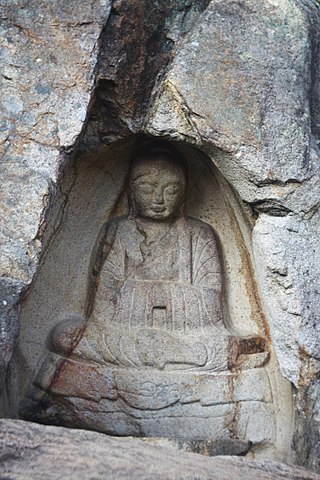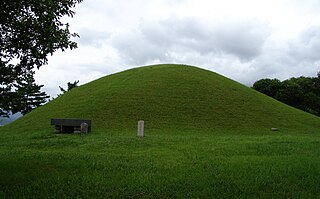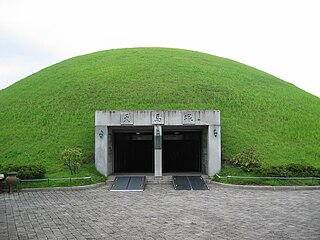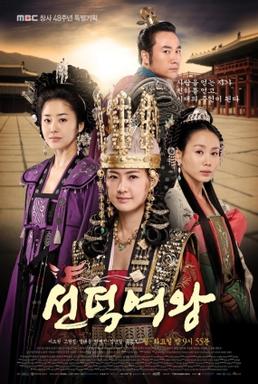
Queen Seondeok of Silla reigned as Queen Regnant of Silla, one of the Three Kingdoms of Korea, from 632 to 647. She was Silla's twenty-seventh ruler, and its first reigning queen. She was the second female sovereign in recorded East Asian history and encouraged a renaissance in thought, literature, and the arts in Silla. In Samguksagi, Queen Seondeok was described as "generous, benevolent, wise, and smart". According to the Legend of Jigwi, she was also beautiful. She developed Buddhist culture, selected great talent, and established diplomacy with the Tang Dynasty, laying the foundation for the unification of the Three Kingdoms of Korea. Queen Seondeok is known as a wise and kind monarch, making her one of the most prominent monarchs in Korean history.
Nulji was the nineteenth ruler (maripgan) of Silla, one of the Three Kingdoms of Korea. He was the son of King Naemul and Lady Boban, who was the daughter of King Michu.
King Jinji of Silla was the 25th ruler of the Korean Kingdom of Silla. He was dethroned three years after his accession.
Jima of Silla was the sixth ruler of Silla, one of the Three Kingdoms of Korea. He is commonly called Jima Isageum, isageum being the royal title in early Silla. As a descendant of Silla's founder Hyeokgeose, his surname was Bak.
Jobun of Silla, also known by his title Jobun Isageum, was the eleventh king of the Korean state of Silla. He was the grandson of Beolhyu Isageum, and a member of the Seok clan. He was the son of Goljeong with Lady Ongmo, a daughter of Kim Gudo. Lady Ongmo's brother was Michu Isageum.
Yurye of Silla, also known as Yuri or by his official title Yurye Isageum, was the fourteenth ruler of the Korean state of Silla. He was a Seok and the son of King Jobun, but his mother was a Park and a descendant of Bak Hyeokgeose.

Jinpyeong was the 26th king of the Silla dynasty, one of the Three Kingdoms of Korea. King Jinpyeong followed in the footsteps of his predecessor, King Jinji, by reorganizing the central ruling system of Silla. Upon the onset of a multitude of conflicts between Baekje and Goguryeo, he sent emissaries to improve relations and strengthen ties between Silla and the Chinese dynasties Sui and Tang. He is also known for his promotion of Buddhism as a spiritual guide for the kingdom and encouraging Buddhist teachings. His 54 year long reign is the longest in Silla's history.
Jinheung the Great was the 24th monarch of Silla, one of the Three Kingdoms of Korea.
Beopheung of Silla was the 23rd monarch of Silla, one of the Three Kingdoms of Korea. He was preceded by King Jijeung and succeeded by King Jinheung.
Soji of Silla was Ruler of Silla. He was preceded by Jabi Maripgan (458–479) and succeeded by King Jijeung (500–514). According to the Samguk Sagi, there was significant development of road infrastructure during his reign.

Naemul of Silla was the 17th ruler of the Korean kingdom of Silla. He was the nephew of King Michu. He married Michu's daughter, Lady Boban. He is given the title Isageum, the same one borne by earlier rulers, in the Samguk Sagi; he is given the title Maripgan, borne by later rulers, in the Samguk Yusa. He is the first to bear the title Maripgan in any record.

Jijeung of Silla (437–514) was the 22nd ruler of the Korean kingdom of Silla. He is remembered for strengthening royal authority and building Silla into a centralized kingdom.

Queen Seondeok is a 2009 South Korean historical drama produced by MBC and Time Box Production for the former's 48th founding anniversary, starring Lee Yo-won, Go Hyun-jung, Uhm Tae-woong, Kim Nam-gil, and Park Ye-jin. It chronicles the life of Queen Seondeok of Silla. It aired on MBC from 25 May to 22 December 2009 on Mondays and Tuesdays at 21:55 for 62 episodes.
Mishil was a Silla aristocrat whose historicity is debated. According to the Hwarang Segi, she was concubine to several kings and, along with his mother Queen Sado, played an instrumental role in dethroning King Jinji.
Lord Bojong (보종공) was a member of Silla's royal family, Hwarang and also the 16th Pungwolju or Gukseon (國仙) from CE 616 to CE 621.
Queen Maya was a member of the Silla royal house and the wife and queen consort to King Jinpyeong of Silla, 26th King of Silla. She was of the royal Kim clan. She was the mother of Queen Seondeok of Silla.
Queen Sado of the Park clan was a Queen Consort of Silla as the spouse of king King Jinheung of Silla, and the mother of his successor, King Jinji of Silla. According to the disputed text Hwarang Segi, she was regent during the minority of her grandson King Jinpyeong but her regent is not mentioned in the historical texts Samguk sagi or Samguk yusa. She later became a Buddhist nun under the name Myobeop.
Crown Prince Dongryun was the eldest son of Jinheung of Silla and Queen Sado. He is the father of Jinpyeong of Silla.
Queen Sinmok of the Gyeongju Kim clan, was the queen regent of Silla between 692 and 700.




